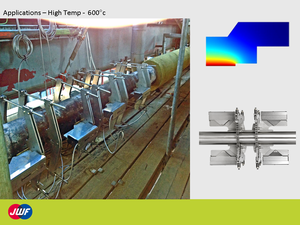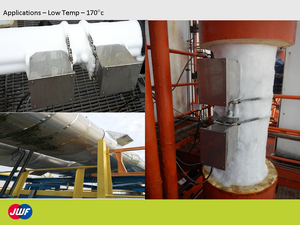I have just attended a Lunch and Learn session delivered by JWF Process Solutions Ltd and hosted by the Institute of Measurement and Control East of Scotland Section.
This presentation focused on clamp on ultrasonic flow meters and their recent developments.
I have had a small amount of experience with clamp on flowmeters in the past and I wasn't overly impressed. The application I had been asked to review the use of the ultrasonic in involved a fluid that under most circumstances was an emulsion. However under certain circumstances the emulsion could be lost and when this occurred the flowmeter would stop reading reliably (the reading would jump from 0 to about 10 times what we reckon was going through the pipe). The conclusion from the project was that the meter was useless for flow control (we needed robust and reliable during these events) however it made an excellent loss-of-emulsion detection system.
According to the presentation, significant advancements have been made since this project. Newer meters are now able to switch between transient (reading through the whole pipe) and Doppler (detecting the movement of particles/bubbles in the fluid). Transient is preferred and gives a more accurate reading however the Doppler would give a reading during these upset periods.
Another interesting development was the use of a coupling mat instead of a gel to connect the transmitter/receiver to the pipe. This still requires a good smooth pipe surface however this material will continue to work well and not require re-fitting every 6 months that gels did.
For use on really hot or cryogenic surfaces, the use of a wave injector allows the transmitter/receivers to be placed a short distance from the pipe and the wave injector (essentially just a metal plate) can radiate the heat difference and keep the sensitive electronics within a suitable temperature range.
As with other flowmeters, they need to be clear of obstructions both upstream and downstream (with guidance given in terms of pipe diameters such as 'minimum 50 pipe diameters downstream of a pump'). However recent research has shown that the effect is repeatable and can be compensated for (with an exponential curve) and as such, it may be possible to fit a flowmeter closer to an obstruction (though still preferred to avoid if possible).
The meters are capable of detecting the speed of sound in the fluid and with the use of temperature compensation, they are capable identifying other fluid properties (detecting density/concentration) or changes in product type.
We were again reminded that as with many things, junk in = junk out and as such, these meters will only work if the correct information is provided. If there is a small error in the pipe diameter, this will translate to a significant final flow error. This can be difficult considering that the reason a strap on flowmeter is being used is generally because you don't have access to the pipe internals. The pipe thickness and outer diameter can be measured. One problem that always exists however is the pipe roughness (though after the presentation the presenter admitted that it often does not make a big difference).
The current main downside to these flowmeters is that they require more connections than the standard two-wire 4-20mA signal that most existing instruments use.
It was interesting to see the developments and while I still would be reluctant to rely on an ultrasonic flow meter, I would be curious to try them out again.
Go Top« An Extra Benefit of Self Driving Cars
Sweaty on a Train »




Comments
I would love to know what you think. To comment on this article, send me an email
No comments yet.